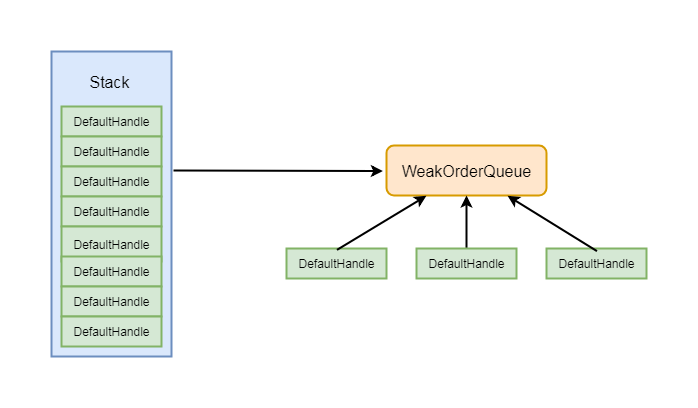Nacos配置中心集群原理
mic 人气:0Nacos作为配置中心,必然需要保证服务节点的高可用性,那么Nacos是如何实现集群的呢?
下面这个图,表示Nacos集群的部署图。

Nacos集群工作原理
Nacos作为配置中心的集群结构中,是一种无中心化节点的设计,由于没有主从节点,也没有选举机制,所以为了能够实现热备,就需要增加虚拟IP(VIP)。
Nacos的数据存储分为两部分
- Mysql数据库存储,所有Nacos节点共享同一份数据,数据的副本机制由Mysql本身的主从方案来解决,从而保证数据的可靠性。
- 每个节点的本地磁盘,会保存一份全量数据,具体路径:/data/program/nacos-1/data/config-data/${GROUP}.
在Nacos的设计中,Mysql是一个中心数据仓库,且认为在Mysql中的数据是绝对正确的。 除此之外,Nacos在启动时会把Mysql中的数据写一份到本地磁盘。
这么设计的好处是可以提高性能,当客户端需要请求某个配置项时,服务端会想Ian从磁盘中读取对应文件返回,而磁盘的读取效率要比数据库效率高。
当配置发生变更时:
- Nacos会把变更的配置保存到数据库,然后再写入本地文件。
- 接着发送一个HTTP请求,给到集群中的其他节点,其他节点收到事件后,从Mysql中dump刚刚写入的数据到本地文件中。
另外,NacosServer启动后,会同步启动一个定时任务,每隔6小时,会dump一次全量数据到本地文件
配置变更同步入口
当配置发生修改、删除、新增操作时,通过发布一个notifyConfigChange事件。
@PostMapping
@Secured(action = ActionTypes.WRITE, parser = ConfigResourceParser.class)
public Boolean publishConfig(HttpServletRequest request, HttpServletResponse response,
@RequestParam(value = "dataId") String dataId, @RequestParam(value = "group") String group,
@RequestParam(value = "tenant", required = false, defaultValue = StringUtils.EMPTY) String tenant,
@RequestParam(value = "content") String content, @RequestParam(value = "tag", required = false) String tag,
@RequestParam(value = "appName", required = false) String appName,
@RequestParam(value = "src_user", required = false) String srcUser,
@RequestParam(value = "config_tags", required = false) String configTags,
@RequestParam(value = "desc", required = false) String desc,
@RequestParam(value = "use", required = false) String use,
@RequestParam(value = "effect", required = false) String effect,
@RequestParam(value = "type", required = false) String type,
@RequestParam(value = "schema", required = false) String schema) throws NacosException {
//省略..
if (StringUtils.isBlank(betaIps)) {
if (StringUtils.isBlank(tag)) {
persistService.insertOrUpdate(srcIp, srcUser, configInfo, time, configAdvanceInfo, true);
ConfigChangePublisher
.notifyConfigChange(new ConfigDataChangeEvent(false, dataId, group, tenant, time.getTime()));
} else {
persistService.insertOrUpdateTag(configInfo, tag, srcIp, srcUser, time, true);
ConfigChangePublisher.notifyConfigChange(
new ConfigDataChangeEvent(false, dataId, group, tenant, tag, time.getTime()));
}
}//省略
return true;
}
AsyncNotifyService
配置数据变更事件,专门有一个监听器AsyncNotifyService,它会处理数据变更后的同步事件。
@Autowired
public AsyncNotifyService(ServerMemberManager memberManager) {
this.memberManager = memberManager;
// Register ConfigDataChangeEvent to NotifyCenter.
NotifyCenter.registerToPublisher(ConfigDataChangeEvent.class, NotifyCenter.ringBufferSize);
// Register A Subscriber to subscribe ConfigDataChangeEvent.
NotifyCenter.registerSubscriber(new Subscriber() {
@Override
public void onEvent(Event event) {
// Generate ConfigDataChangeEvent concurrently
if (event instanceof ConfigDataChangeEvent) {
ConfigDataChangeEvent evt = (ConfigDataChangeEvent) event;
long dumpTs = evt.lastModifiedTs;
String dataId = evt.dataId;
String group = evt.group;
String tenant = evt.tenant;
String tag = evt.tag;
Collection<Member> ipList = memberManager.allMembers(); //得到集群中的ip列表
// 构建NotifySingleTask,并添加到队列中。
Queue<NotifySingleTask> queue = new LinkedList<NotifySingleTask>();
for (Member member : ipList) { //遍历集群中的每个节点
queue.add(new NotifySingleTask(dataId, group, tenant, tag, dumpTs, member.getAddress(),
evt.isBeta));
}
//异步执行任务 AsyncTask
ConfigExecutor.executeAsyncNotify(new AsyncTask(nacosAsyncRestTemplate, queue));
}
}
@Override
public Class<? extends Event> subscribeType() {
return ConfigDataChangeEvent.class;
}
});
}
AsyncTask
@Override
public void run() {
executeAsyncInvoke();
}
private void executeAsyncInvoke() {
while (!queue.isEmpty()) {//遍历队列中的数据,直到数据为空
NotifySingleTask task = queue.poll(); //获取task
String targetIp = task.getTargetIP(); //获取目标ip
if (memberManager.hasMember(targetIp)) { //如果集群中的ip列表包含目标ip
// start the health check and there are ips that are not monitored, put them directly in the notification queue, otherwise notify
//判断目标ip的健康状态
boolean unHealthNeedDelay = memberManager.isUnHealth(targetIp); //
if (unHealthNeedDelay) { //如果目标服务是非健康,则继续添加到队列中,延后再执行。
// target ip is unhealthy, then put it in the notification list
ConfigTraceService.logNotifyEvent(task.getDataId(), task.getGroup(), task.getTenant(), null,
task.getLastModified(), InetUtils.getSelfIP(), ConfigTraceService.NOTIFY_EVENT_UNHEALTH,
0, task.target);
// get delay time and set fail count to the task
asyncTaskExecute(task);
} else {
//构建header
Header header = Header.newInstance();
header.addParam(NotifyService.NOTIFY_HEADER_LAST_MODIFIED, String.valueOf(task.getLastModified()));
header.addParam(NotifyService.NOTIFY_HEADER_OP_HANDLE_IP, InetUtils.getSelfIP());
if (task.isBeta) {
header.addParam("isBeta", "true");
}
AuthHeaderUtil.addIdentityToHeader(header);
//通过restTemplate发起远程调用,如果调用成功,则执行AsyncNotifyCallBack的回调方法
restTemplate.get(task.url, header, Query.EMPTY, String.class, new AsyncNotifyCallBack(task));
}
}
}
}
目标节点接收请求
数据同步的请求地址为,task.url=http://192.168.8.16:8848/nacos/v1/cs/communication/dataChange?dataId=log.yaml&group=DEFAULT_GROUP
@GetMapping("/dataChange")
public Boolean notifyConfigInfo(HttpServletRequest request, @RequestParam("dataId") String dataId,
@RequestParam("group") String group,
@RequestParam(value = "tenant", required = false, defaultValue = StringUtils.EMPTY) String tenant,
@RequestParam(value = "tag", required = false) String tag) {
dataId = dataId.trim();
group = group.trim();
String lastModified = request.getHeader(NotifyService.NOTIFY_HEADER_LAST_MODIFIED);
long lastModifiedTs = StringUtils.isEmpty(lastModified) ? -1 : Long.parseLong(lastModified);
String handleIp = request.getHeader(NotifyService.NOTIFY_HEADER_OP_HANDLE_IP);
String isBetaStr = request.getHeader("isBeta");
if (StringUtils.isNotBlank(isBetaStr) && trueStr.equals(isBetaStr)) {
dumpService.dump(dataId, group, tenant, lastModifiedTs, handleIp, true);
} else {
//
dumpService.dump(dataId, group, tenant, tag, lastModifiedTs, handleIp);
}
return true;
}
dumpService.dump用来实现配置的更新,代码如下
当前任务会被添加到DumpTaskMgr中管理。
public void dump(String dataId, String group, String tenant, String tag, long lastModified, String handleIp,
boolean isBeta) {
String groupKey = GroupKey2.getKey(dataId, group, tenant);
String taskKey = String.join("+", dataId, group, tenant, String.valueOf(isBeta), tag);
dumpTaskMgr.addTask(taskKey, new DumpTask(groupKey, tag, lastModified, handleIp, isBeta));
DUMP_LOG.info("[dump-task] add task. groupKey={}, taskKey={}", groupKey, taskKey);
}
TaskManager.addTask, 先调用父类去完成任务添加。
@Override
public void addTask(Object key, AbstractDelayTask newTask) {
super.addTask(key, newTask);
MetricsMonitor.getDumpTaskMonitor().set(tasks.size());
}
在这种场景设计中,一般都会采用生产者消费者模式来完成,因此这里不难猜测到,任务会被保存到一个队列中,然后有另外一个线程来执行。
NacosDelayTaskExecuteEngine
TaskManager的父类是NacosDelayTaskExecuteEngine,
这个类中有一个成员属性protected final ConcurrentHashMap<Object, AbstractDelayTask> tasks;,专门来保存延期执行的任务类型AbstractDelayTask.
在这个类的构造方法中,初始化了一个延期执行的任务,其中具体的任务是ProcessRunnable.
public NacosDelayTaskExecuteEngine(String name, int initCapacity, Logger logger, long processInterval) {
super(logger);
tasks = new ConcurrentHashMap<Object, AbstractDelayTask>(initCapacity);
processingExecutor = ExecutorFactory.newSingleScheduledExecutorService(new NameThreadFactory(name));
processingExecutor
.scheduleWithFixedDelay(new ProcessRunnable(), processInterval, processInterval, TimeUnit.MILLISECONDS);
}
ProcessRunnable
private class ProcessRunnable implements Runnable {
@Override
public void run() {
try {
processTasks();
} catch (Throwable e) {
getEngineLog().error(e.toString(), e);
}
}
}
processTasks
protected void processTasks() {
//获取所有的任务
Collection<Object> keys = getAllTaskKeys();
for (Object taskKey : keys) {
AbstractDelayTask task = removeTask(taskKey);
if (null == task) {
continue;
}
//获取任务处理器,这里返回的是DumpProcessor
NacosTaskProcessor processor = getProcessor(taskKey);
if (null == processor) {
getEngineLog().error("processor not found for task, so discarded. " + task);
continue;
}
try {
// ReAdd task if process failed
//执行具体任务
if (!processor.process(task)) {
retryFailedTask(taskKey, task);
}
} catch (Throwable e) {
getEngineLog().error("Nacos task execute error : " + e.toString(), e);
retryFailedTask(taskKey, task);
}
}
}
DumpProcessor.process
读取数据库的最新数据,然后更新本地缓存和磁盘
加载全部内容